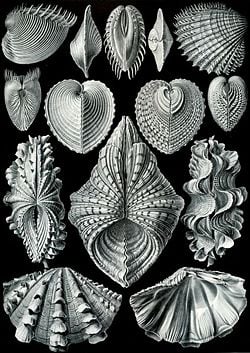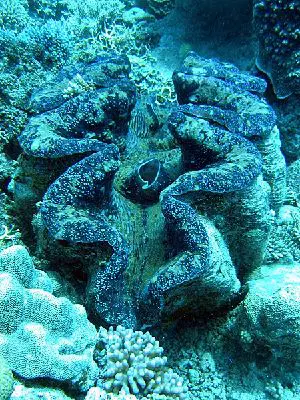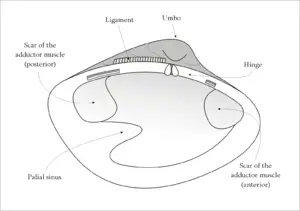Difference between revisions of "Bivalve" - New World Encyclopedia
Rick Swarts (talk | contribs) |
Rick Swarts (talk | contribs) |
||
| Line 40: | Line 40: | ||
The class has about 30,000 [[species]], making them the second most diverse class of mollusks after [[Gastropoda]] ("univalves"). There are both marine and freshwater forms. Most bivalves are relatively sedentary suspension feeders, although they have various levels of activity, including usng the foot to move; some that can swim by waving the foot or tentacles; and some that can jet-propel themselves by rapidly clapping the shell valves together (reference 2003). | The class has about 30,000 [[species]], making them the second most diverse class of mollusks after [[Gastropoda]] ("univalves"). There are both marine and freshwater forms. Most bivalves are relatively sedentary suspension feeders, although they have various levels of activity, including usng the foot to move; some that can swim by waving the foot or tentacles; and some that can jet-propel themselves by rapidly clapping the shell valves together (reference 2003). | ||
| + | |||
| + | oysters become permanentl attache to hard surface early in development\\\\\\\ | ||
| + | scallops move by opeing valves and rapidly snapping shut | ||
| + | shipworm "one of few bivalves that does not filter feed" (Towle 1989). bores into drift wood and ingests particles produced by driling and use symbiot protozoa. | ||
| + | |||
| + | |||
[[symmetry (biology)#Bilateral symmetry|bilateral body symmetry]], | [[symmetry (biology)#Bilateral symmetry|bilateral body symmetry]], | ||
| Line 61: | Line 67: | ||
"The habitat of a bivalve is often reflected in the form of its shell. Nestlers and cementing bivalves frequently take the shape of their substrates. Individuals in calm waters often have more delicate and leaflike shell scuplture than their counterparts in fast-flowing currents." | "The habitat of a bivalve is often reflected in the form of its shell. Nestlers and cementing bivalves frequently take the shape of their substrates. Individuals in calm waters often have more delicate and leaflike shell scuplture than their counterparts in fast-flowing currents." | ||
| + | \\\ | ||
| + | |||
| + | |||
| + | As with all, Mollusks, bivalves are characterized by having a true coelom; organ systems for circulation, respiration, digestion, excretion, nerve conduction, and reproduction; and most mollusks have one or more shells and are bilaterially symmetrical (Towle 1989). | ||
| + | complete digestive tract, reduced nervours ystem, open circulatory sstyem with heart, arteries, venins; and excretory and reproducitve organs. | ||
| + | |||
| + | lack cephalic eyes and other sense organs, but many have tentacles and/or photorecopetors. More sophisticated eyes, equipped with retina and lens, are fundi n several families. | ||
| − | |||
| + | However, whereas a mollusk typically has a body divided into the three parts of head, visceral mass, and muscular foot; | ||
| + | |||
| + | However, in mollusks the head is much reduced and not very distinct.???? | ||
some say have no head and some say is reduced! | some say have no head and some say is reduced! | ||
scallops lacka foot, and both oysters and giant clams lack a foot as adults. | scallops lacka foot, and both oysters and giant clams lack a foot as adults. | ||
| − | + | ||
shell: two vlaues, with noncalcified conntecting ligament holding the valves together at a hinge plate. Hinged dorsally (above the body) and open ventrally (below the body). Usually similar and equal in szie, but some, such as oyster, the left-hand or upper valve is larger than the lower valavle. two muselces acitng antagonistiallcy to hinge ligament, enable shell to close. | shell: two vlaues, with noncalcified conntecting ligament holding the valves together at a hinge plate. Hinged dorsally (above the body) and open ventrally (below the body). Usually similar and equal in szie, but some, such as oyster, the left-hand or upper valve is larger than the lower valavle. two muselces acitng antagonistiallcy to hinge ligament, enable shell to close. | ||
| Line 79: | Line 94: | ||
Bivalves lack a [[radula]] and feed by siphoning and filtering large particles from water. Some bivalves are [[Fauna (animals)#Epifauna|epifaunal]]: that is, they attach themselves to surfaces in the water, by means of a [[byssus]] or organic cementation. Others are [[Fauna (animals)#Infauna|infaunal]]: they bury themselves in sand or other sediments. These forms typically have a strong digging foot. Some bivalves can swim. | Bivalves lack a [[radula]] and feed by siphoning and filtering large particles from water. Some bivalves are [[Fauna (animals)#Epifauna|epifaunal]]: that is, they attach themselves to surfaces in the water, by means of a [[byssus]] or organic cementation. Others are [[Fauna (animals)#Infauna|infaunal]]: they bury themselves in sand or other sediments. These forms typically have a strong digging foot. Some bivalves can swim. | ||
| − | Usiuglaly | + | Usiuglaly separate sexes. Shed into water, external fertilization. Sme are consecutive or simultaneous hermaphrodites. |
external sexual dimorphism is rate. | external sexual dimorphism is rate. | ||
Revision as of 03:02, 17 February 2007
| Bivalve | ||||||
|---|---|---|---|---|---|---|
 "Acephala" from Ernst Haeckel's Kunstformen der Natur, 1904
| ||||||
| Scientific classification | ||||||
| ||||||
|
Subclass Anomalosdesmata
Subclass Heterodonta - clams, zebra mussels
Subclass Paleoheterodonta
Subclass Protobranchia
Subclass Pteriomorphia - oysters, mussels
|
Bivalves are aquatic mollusks belonging to the class Bivalvia ("two valves")—also referred to as class Pelecypoda ("hatchet-foot")—a group that includes the familiar and economically important clams, oysters, scallops, and mussels. Bivalvia refers to the fact that most members of this group have two-part calcareous shells (valves) that are hinged and more or less symmetrical. Pelecypoda refers to the laterally compressed muscular foot that when extended into sediment (sand or mud), can swell with blood and form a hatchet-shaped anchor (Towle 1989). Other names for the class include Bivalva and Lamellibranchia
Bivalves are (generally) laterally compressed body and have a shell composed of two valves. The valved shell makes them superficially similar to brachiopods, but the construction of the shell is completely different in the two groups: in brachiopods, the two valves are on the upper and lower surfaces of the body, while in bivalves, they are on the left and right sides.
The class has about 30,000 species, making them the second most diverse class of mollusks after Gastropoda ("univalves"). There are both marine and freshwater forms. Most bivalves are relatively sedentary suspension feeders, although they have various levels of activity, including usng the foot to move; some that can swim by waving the foot or tentacles; and some that can jet-propel themselves by rapidly clapping the shell valves together (reference 2003).
oysters become permanentl attache to hard surface early in development\\\\\\\ scallops move by opeing valves and rapidly snapping shut shipworm "one of few bivalves that does not filter feed" (Towle 1989). bores into drift wood and ingests particles produced by driling and use symbiot protozoa.
human consumption (clams, mussels, oysters, scallops, cockles) for fish, vertebrates, other invertebrates, and humans (Grzimek 2003). cultured pearls pearl production
bivalves filter feeders — "frequent vectors of human disease related to concentration of bacteria, viruses, pesticides, industrial wastes, toxic metals, and petroleum derivatives fromt eh wter column". shipworms (Teredinidae) "have a long historical record of bioerosion of human-made wooden structures as ships and docks". clog water treatment plants
"Freshwater pearl mussels are among the world's most gravely threatened fauna." IN eastern North America, 35% of the 297 native species are presumed extinct, with another 69% listed formally as endageered or threatened. causes: pollution, habitat alteration (damming, dredging).. including damaging fish hosts "one-hundred ninety-five species of bivalves have been placed onthe 2002 IUCN Red List; all but 10 of these are freshwater pearl mussels." Marine bivalves: "no known recent extinctions and none are currently listed as threatened or endangered."
Characteristics
Found worldwide all aquatic "requring wter for reproductive processes, respiration, and typically for feeding". intertidal zone to deep sea. "The habitat of a bivalve is often reflected in the form of its shell. Nestlers and cementing bivalves frequently take the shape of their substrates. Individuals in calm waters often have more delicate and leaflike shell scuplture than their counterparts in fast-flowing currents."
\\\
As with all, Mollusks, bivalves are characterized by having a true coelom; organ systems for circulation, respiration, digestion, excretion, nerve conduction, and reproduction; and most mollusks have one or more shells and are bilaterially symmetrical (Towle 1989).
complete digestive tract, reduced nervours ystem, open circulatory sstyem with heart, arteries, venins; and excretory and reproducitve organs.
lack cephalic eyes and other sense organs, but many have tentacles and/or photorecopetors. More sophisticated eyes, equipped with retina and lens, are fundi n several families.
However, whereas a mollusk typically has a body divided into the three parts of head, visceral mass, and muscular foot;
However, in mollusks the head is much reduced and not very distinct.???? some say have no head and some say is reduced!
scallops lacka foot, and both oysters and giant clams lack a foot as adults.
shell: two vlaues, with noncalcified conntecting ligament holding the valves together at a hinge plate. Hinged dorsally (above the body) and open ventrally (below the body). Usually similar and equal in szie, but some, such as oyster, the left-hand or upper valve is larger than the lower valavle. two muselces acitng antagonistiallcy to hinge ligament, enable shell to close.
Bivalves are filter-feeders that use their gills to extract organic matter from the water in which they live. They have an open circulatory system that bathes the organs in hemolymph. Nephridia remove the waste material.
Eat: small crustaceans, worms, some symbiotic with chemoautotropihi bacteria and photosynethtci organisms. wood-eathing Teredinidae have symbiotic cellulose-digesting bactria
Bivalves lack a radula and feed by siphoning and filtering large particles from water. Some bivalves are epifaunal: that is, they attach themselves to surfaces in the water, by means of a byssus or organic cementation. Others are infaunal: they bury themselves in sand or other sediments. These forms typically have a strong digging foot. Some bivalves can swim.
Usiuglaly separate sexes. Shed into water, external fertilization. Sme are consecutive or simultaneous hermaphrodites. external sexual dimorphism is rate.
free-swimming veliger larva feed in plankton. Teh settlement. Freshwater mussels have specialized larvae that "require attachment to the gills or fins fof ish to complete their life cycles."
History
extensive fossil record begin cambiran Bivalves appeared late in the Cambrian explosion and came to dominate over brachiopods during the Palaeozoic; indeed, by the end-Permian extinction, bivalves were undergoing a huge radiation in numbers while brachiopods (along with ~95% of all species) were devastated.
"by the middle Ordovician (about 460 mya), recognizable members of all modern subclasses had appeared".
This raises two questions: how did the bivalves come to challenge the brachiopoda niche before the extinction event, and how did the bivalves escape the fate of extinction? Although inevitable biases exist in the fossil record and our documentation thereof, bivalves essentially appear to be better adapted to aquatic life. Far more sophisticated than the brachiopods, bivalves use an energetically-efficient ligament-muscle system for opening valves, and thus require less food to subsist. Furthermore, their ability to burrow allows for evasion of predators: buried bivalves feed by extending a siphon to the surface (indicated by the presence of a palial sinus, the size of which is proportional to the burrowing depth, and represented by their dentition). Additionally, bivalves became mobile: some developed spines for buoyancy, while others suck in and eject water to enable propulsion. This allowed bivalves to themselves become predators.
With such a wide range of adaptations it is unsurprising that the shapes of bivalve shells vary greatly - some are rounded and globular, others are flattened and plate-like, while still others, such as the razor shell Ensis, have become greatly elongated in order to aid burrowing byssonychia. The shipworms of the family Teredinidae have elongated bodies, but the shell valves are much reduced and restricted to the anterior end of the body. They function as burrowing organs, allowing the animal to dig tunnels through wood.
Some pelecypods are alive today in the Great Sea and the Black Sea. Various Eurasian countries rely on them for food.
Taxonomy
Move down from top and shorten the top to just subclasses "Current classification schemes recognize five subclasses of bivalves". Protobranchia — use simple gills for respiration and enlarged labial papls for collectin food Pteriomorhia — most familiar bivavles, have eipbenthic habiate, unfused mantle ede and areduced foot etc.
External links
- Museum of Paleontology - Palaeontology from the University of California, Berkeley
Credits
New World Encyclopedia writers and editors rewrote and completed the Wikipedia article in accordance with New World Encyclopedia standards. This article abides by terms of the Creative Commons CC-by-sa 3.0 License (CC-by-sa), which may be used and disseminated with proper attribution. Credit is due under the terms of this license that can reference both the New World Encyclopedia contributors and the selfless volunteer contributors of the Wikimedia Foundation. To cite this article click here for a list of acceptable citing formats.The history of earlier contributions by wikipedians is accessible to researchers here:
The history of this article since it was imported to New World Encyclopedia:
Note: Some restrictions may apply to use of individual images which are separately licensed.

